PEUGEOT 308 2016 Owners Manual
Manufacturer: PEUGEOT, Model Year: 2016, Model line: 308, Model: Peugeot 308 2016Pages: 344, PDF Size: 12.23 MB
Page 211 of 344

209
3008_en_Chap10_infos-pratiques_ed01-2015
Putting the wheel back in place
F Put the wheel back in its housing.
F U nscrew the yellow central bolt by a few
turns then put it in place in the centre of the
w h e e l*.
F
T
ighten fully until the central bolt clicks to
retain the wheel correctly*.
Changing a wheel
Spare wheel
The spare wheel is installed in the boot under
t h e f l o o r.
Depending on equipment, the spare wheel may
be steel, alloy or of the "space-saver" type.
For access to it, refer to the "Tool kit" section.
Taking out the wheel
F Unscrew the yellow central bolt*.
F R aise the spare wheel towards you from
the rear.
F
T
ake the wheel out of the boot.
Procedure for removing a wheel with a damaged or punctured tyre and fitting the spare wheel using the tools supplied with the vehicle.
See the "Tool kit" section.
* Except BlueHDi versions.
BlueHDi versions only: the spare wheel
is placed on the tools.
Do not forget to secure the jack at the
bottom of the well and refit the storage
box before returning the spare wheel.
The jack must only be used for changing a
wheel with a damaged or punctured tyre.
The jack does not require any
maintenance.
10
Practical information
Page 212 of 344
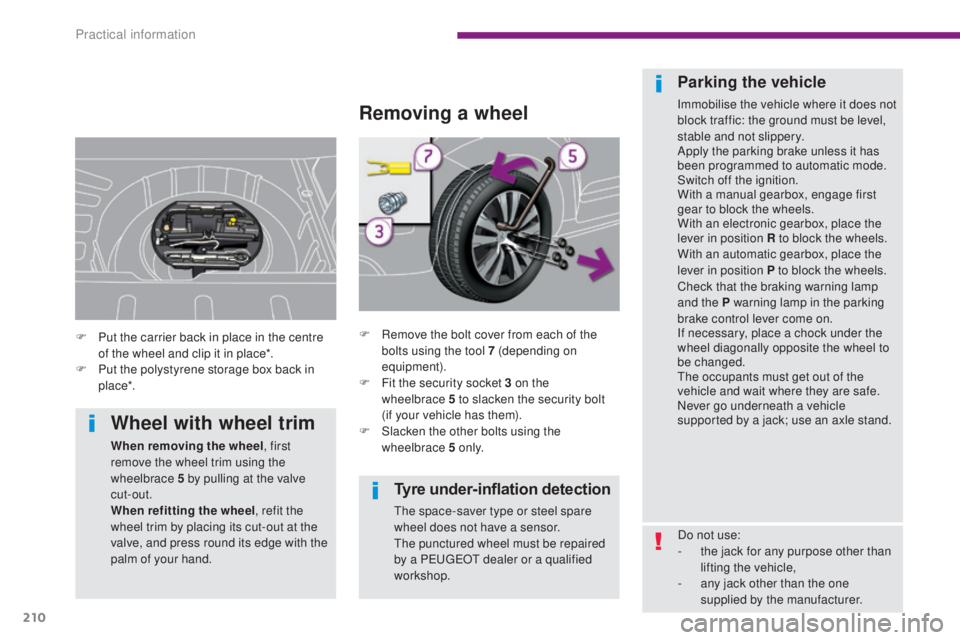
210
3008_en_Chap10_infos-pratiques_ed01-2015
Tyre under-inflation detection
The space-saver type or steel spare
wheel does not have a sensor.
The punctured wheel must be repaired
by a PEUGEOT dealer or a qualified
workshop.
Removing a wheel
F Remove the bolt cover from each of the bolts using the tool 7 (depending on
equipment).
F
F
it the security socket 3 on the
wheelbrace
5 to slacken the security bolt
(if
your vehicle has them).
F
S
lacken the other bolts using the
wheelbrace 5 o n l y.
Parking the vehicle
Immobilise the vehicle where it does not
block traffic: the ground must be level,
stable and not slippery.
Apply the parking brake unless it has
been programmed to automatic mode.
Switch off the ignition.
With a manual gearbox, engage first
gear to block the wheels.
With an electronic gearbox, place the
lever in position R to block the wheels.
With an automatic gearbox, place the
lever in position P to block the wheels.
Check that the braking warning lamp
and the P warning lamp in the parking
brake control lever come on.
If necessary, place a chock under the
wheel diagonally opposite the wheel to
be changed.
The occupants must get out of the
vehicle and wait where they are safe.
Never go underneath a vehicle
supported by a jack; use an axle stand.
F
P
ut the carrier back in place in the centre
of the wheel and clip it in place*.
F
P
ut the polystyrene storage box back in
p lac e*.
Wheel with wheel trim
When removing the wheel , first
remove the wheel trim using the
wheelbrace 5 by pulling at the valve
cut-out.
When refitting the wheel , refit the
wheel trim by placing its cut-out at the
valve, and press round its edge with the
palm of your hand. Do not use:
-
t
he jack for any purpose other than
lifting the vehicle,
-
a
ny jack other than the one
supplied by the manufacturer.
Practical information
Page 213 of 344
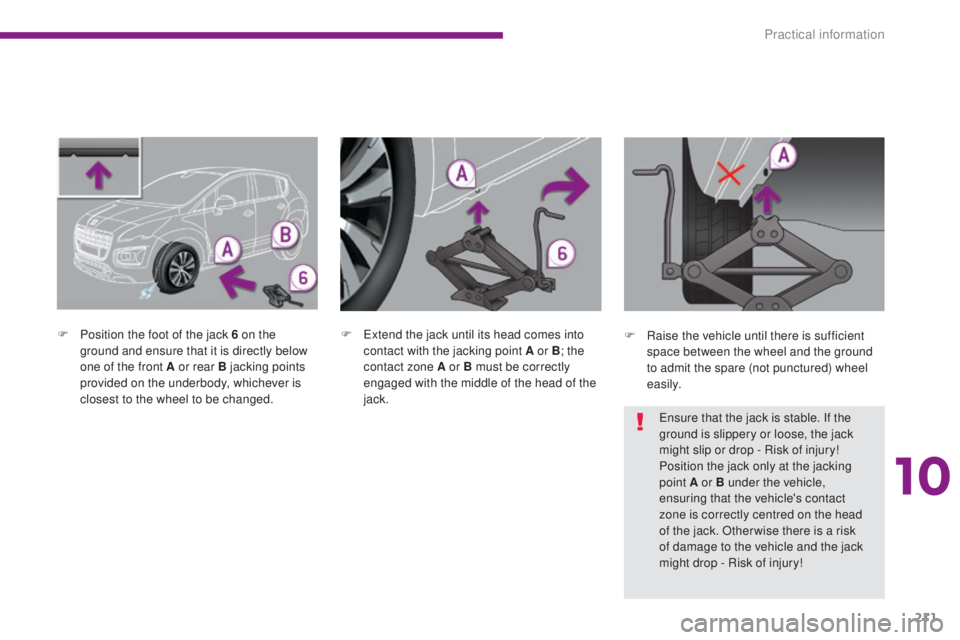
211
3008_en_Chap10_infos-pratiques_ed01-2015
F Position the foot of the jack 6 on the ground and ensure that it is directly below
one of the front A or rear B jacking points
provided on the underbody, whichever is
closest to the wheel to be changed. F
E xtend the jack until its head comes into
contact with the jacking point A or B ; the
contact zone A or B must be correctly
engaged with the middle of the head of the
jack. F
Ra ise the vehicle until there is sufficient
space between the wheel and the ground
to admit the spare (not punctured) wheel
easily.
Ensure that the jack is stable. If the
ground is slippery or loose, the jack
might slip or drop - Risk of injury!
Position the jack only at the jacking
point A or B under the vehicle,
ensuring that the vehicle's contact
zone is correctly centred on the head
of the jack. Otherwise there is a risk
of damage to the vehicle and the jack
might drop - Risk of injury!
10
Practical information
Page 214 of 344
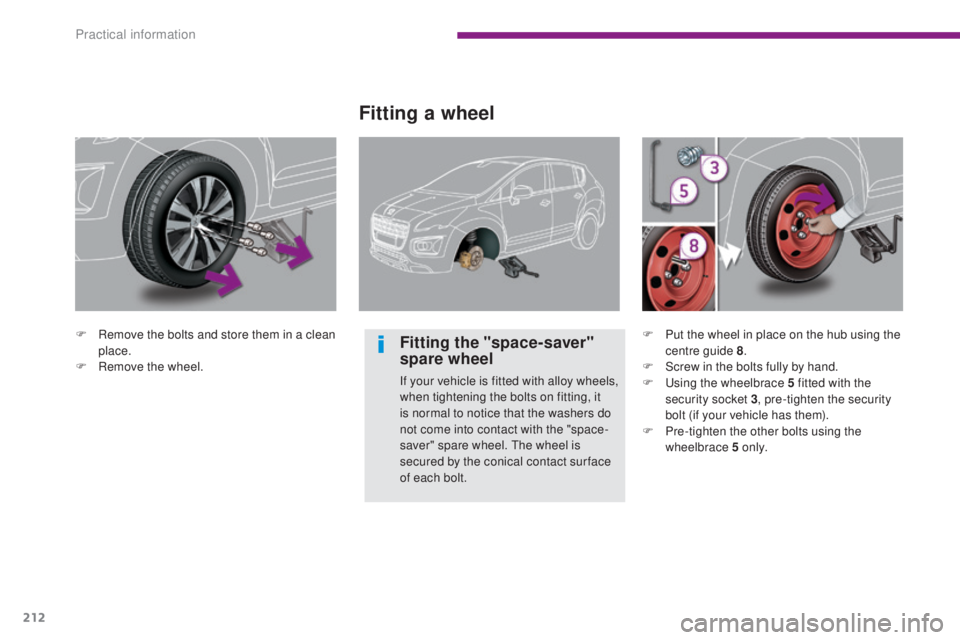
212
3008_en_Chap10_infos-pratiques_ed01-2015
F Remove the bolts and store them in a clean place.
F
R
emove the wheel.
Fitting a wheel
Fitting the "space-saver"
spare wheel
If your vehicle is fitted with alloy wheels,
when tightening the bolts on fitting, it
is normal to notice that the washers do
not come into contact with the "space-
saver" spare wheel. The wheel is
secured by the conical contact sur face
of each bolt. F
P
ut the wheel in place on the hub using the
centre guide 8 .
F S crew in the bolts fully by hand.
F U sing the wheelbrace 5 fitted with the
security socket 3 , pre-tighten the security
bolt (if your vehicle has them).
F
P
re-tighten the other bolts using the
wheelbrace 5 o n l y.
Practical information
Page 215 of 344
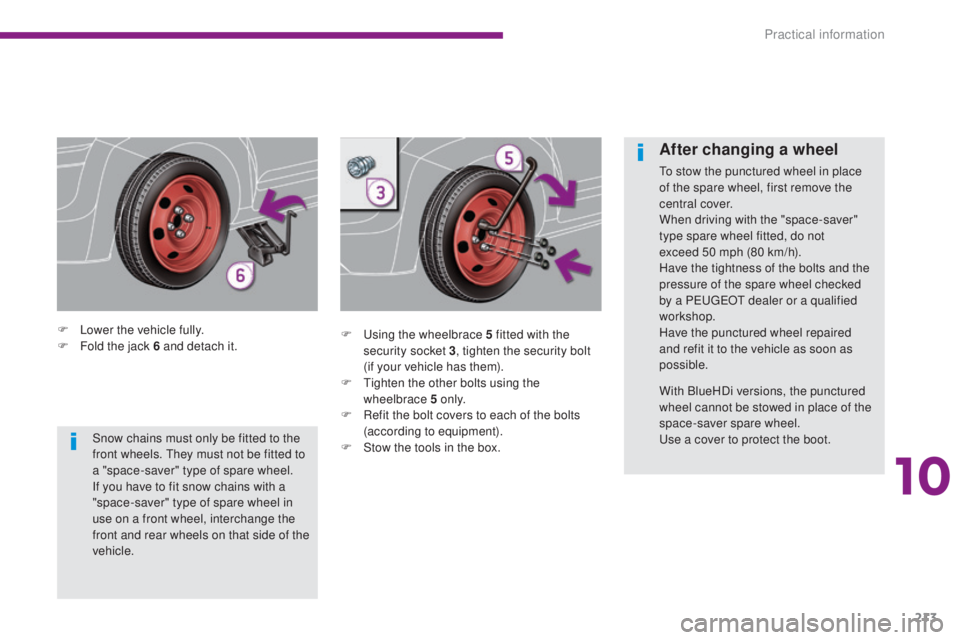
213
3008_en_Chap10_infos-pratiques_ed01-2015
F Lower the vehicle fully.
F F old the jack 6 and detach it. F
U sing the wheelbrace 5 fitted with the
security socket 3 , tighten the security bolt
(if your vehicle has them).
F
T
ighten the other bolts using the
wheelbrace 5 o n l y.
F
R
efit the bolt covers to each of the bolts
(according to equipment).
F
S
tow the tools in the box.
After changing a wheel
To stow the punctured wheel in place
of the spare wheel, first remove the
central cover.
When driving with the "space-saver"
type spare wheel fitted, do not
exceed 50 mph (80 km/h).
Have the tightness of the bolts and the
pressure of the spare wheel checked
by a PEUGEOT dealer or a qualified
workshop.
Have the punctured wheel repaired
and refit it to the vehicle as soon as
possible.
With BlueHDi versions, the punctured
wheel cannot be stowed in place of the
space-saver spare wheel.
Use a cover to protect the boot.
Snow chains must only be fitted to the
front wheels. They must not be fitted to
a "space-saver" type of spare wheel.
If you have to fit snow chains with a
"space-saver" type of spare wheel in
use on a front wheel, interchange the
front and rear wheels on that side of the
vehicle.
10
Practical information
Page 216 of 344
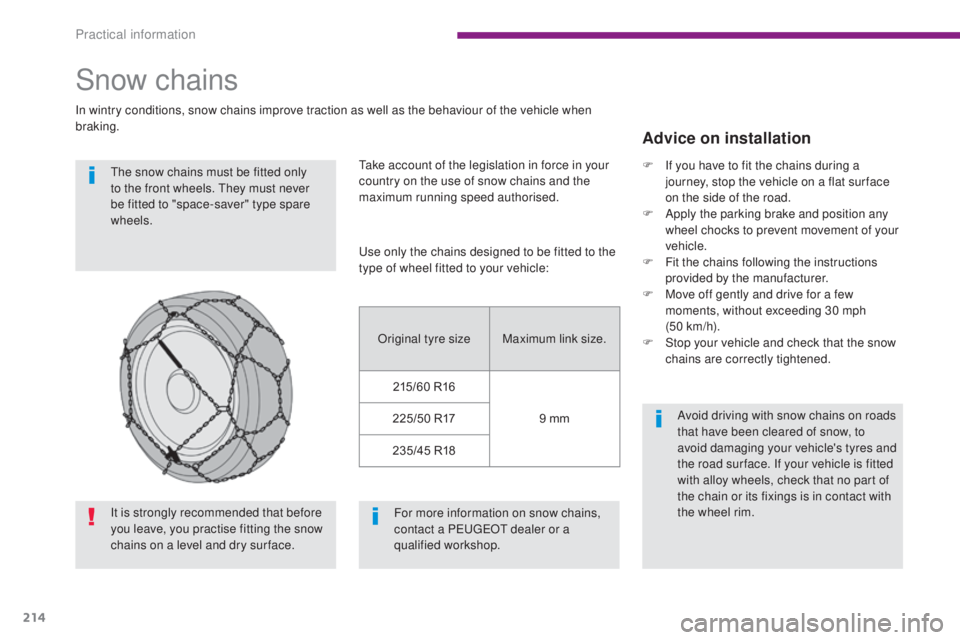
214
3008_en_Chap10_infos-pratiques_ed01-2015
Snow chains
In wintry conditions, snow chains improve traction as well as the behaviour of the vehicle when
braking.The snow chains must be fitted only
to the front wheels. They must never
be fitted to "space-saver" type spare
wheels. Take account of the legislation in force in your
country on the use of snow chains and the
maximum running speed authorised.
Advice on installation
Avoid driving with snow chains on roads
that have been cleared of snow, to
avoid damaging your vehicle's tyres and
the road sur face. If your vehicle is fitted
with alloy wheels, check that no part of
the chain or its fixings is in contact with
the wheel rim.
For more information on snow chains,
contact a PEUGEOT dealer or a
qualified workshop.
Use only the chains designed to be fitted to the
type of wheel fitted to your vehicle:
Original tyre size Maximum link size.
215/60 R16 9 mm
225/50 R17
235/45 R18 F
I
f you have to fit the chains during a
journey, stop the vehicle on a flat sur face
on the side of the road.
F
A
pply the parking brake and position any
wheel chocks to prevent movement of your
vehicle.
F
F
it the chains following the instructions
provided by the manufacturer.
F
M
ove off gently and drive for a few
moments, without exceeding 30 mph
(50
km/h).
F
S
top your vehicle and check that the snow
chains are correctly tightened.
It is strongly recommended that before
you leave, you practise fitting the snow
chains on a level and dry sur face.
Practical information
Page 217 of 344
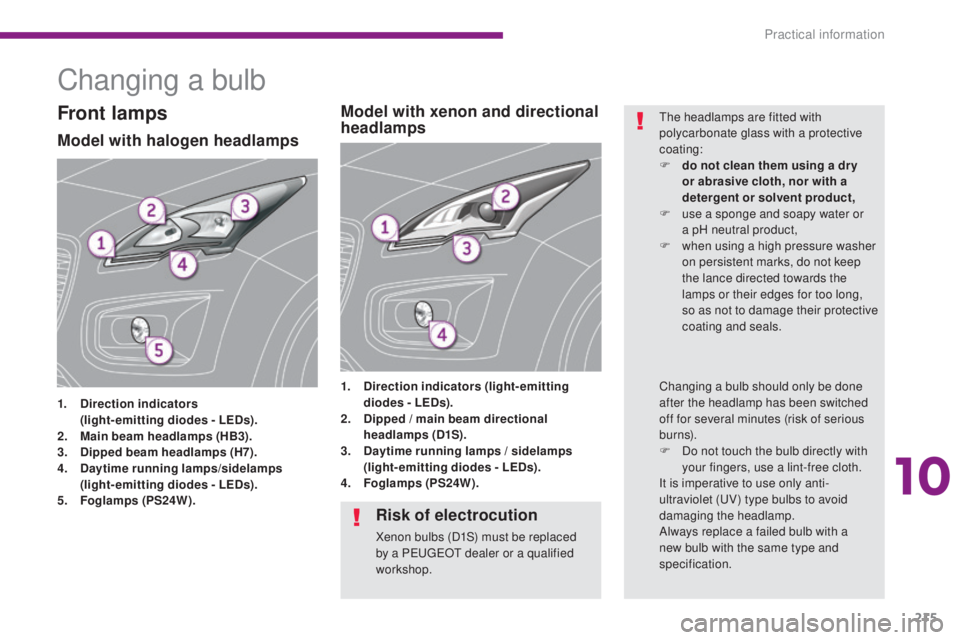
215
3008_en_Chap10_infos-pratiques_ed01-2015
Changing a bulb
Model with halogen headlamps
1. Direction indicators (
light-emitting diodes - LEDs).
2.
M
ain beam headlamps (HB3).
3.
D
ipped beam headlamps (H7).
4.
D
aytime running lamps/sidelamps
(
light-emitting diodes - LEDs).
5.
F
oglamps (PS24W). 1.
D
irection indicators (light-emitting
diodes - LEDs).
2. D ipped / main beam directional
headlamps (D1S).
3.
D
aytime running lamps / sidelamps
(light-emitting diodes - LEDs).
4.
F
oglamps (PS24W).
Model with xenon and directional
headlampsFront lampsThe headlamps are fitted with
polycarbonate glass with a protective
coating:
F
d
o not clean them using a dr y
or abrasive cloth, nor with a
detergent or solvent product,
F
u
se a sponge and soapy water or
a
pH neutral product,
F
w
hen using a high pressure washer
on persistent marks, do not keep
the lance directed towards the
lamps or their edges for too long,
so as not to damage their protective
coating and seals.
Risk of electrocution
Xenon bulbs (D1S) must be replaced
by a PEUGEOT dealer or a qualified
workshop. Changing a bulb should only be done
after the headlamp has been switched
off for several minutes (risk of serious
burns).
F
D
o not touch the bulb directly with
your fingers, use a lint-free cloth.
It is imperative to use only anti-
ultraviolet (UV) type bulbs to avoid
damaging the headlamp.
Always replace a failed bulb with a
new bulb with the same type and
specification.
10
Practical information
Page 218 of 344
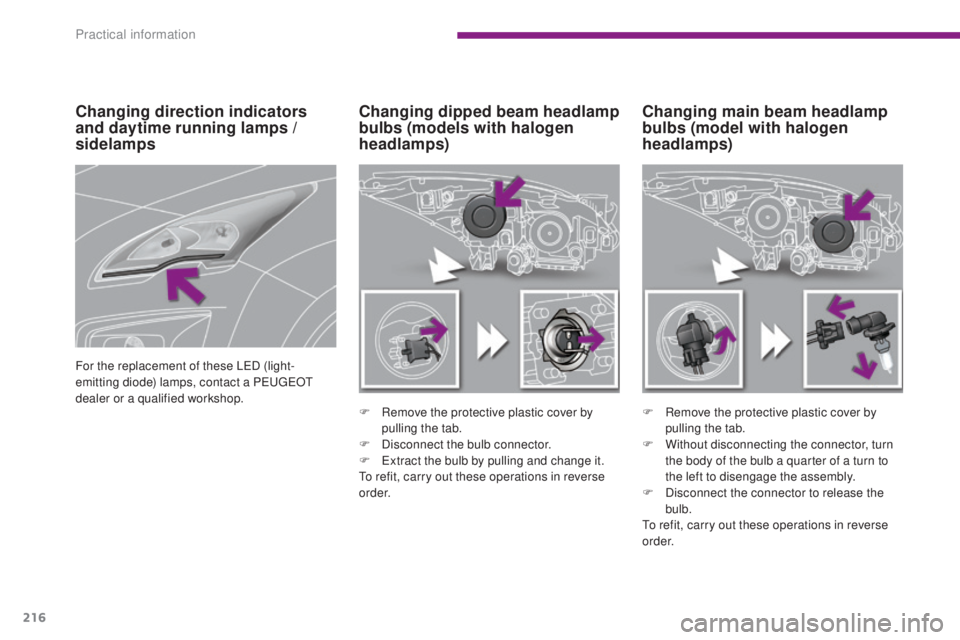
216
3008_en_Chap10_infos-pratiques_ed01-2015
Changing main beam headlamp
bulbs (model with halogen
headlamps)
Changing dipped beam headlamp
bulbs (models with halogen
headlamps)
F Remove the protective plastic cover by
pulling the tab.
F
D
isconnect the bulb connector.
F
E
xtract the bulb by pulling and change it.
To refit, carry out these operations in reverse
o r d e r. F
R emove the protective plastic cover by
pulling the tab.
F
W
ithout disconnecting the connector, turn
the body of the bulb a quarter of a turn to
the left to disengage the assembly.
F
D
isconnect the connector to release the
bulb.
To refit, carry out these operations in reverse
o r d e r.
Changing direction indicators
and daytime running lamps /
sidelamps
For the replacement of these LED (light-
emitting diode) lamps, contact a PEUGEOT
dealer or a qualified workshop.
Practical information
Page 219 of 344
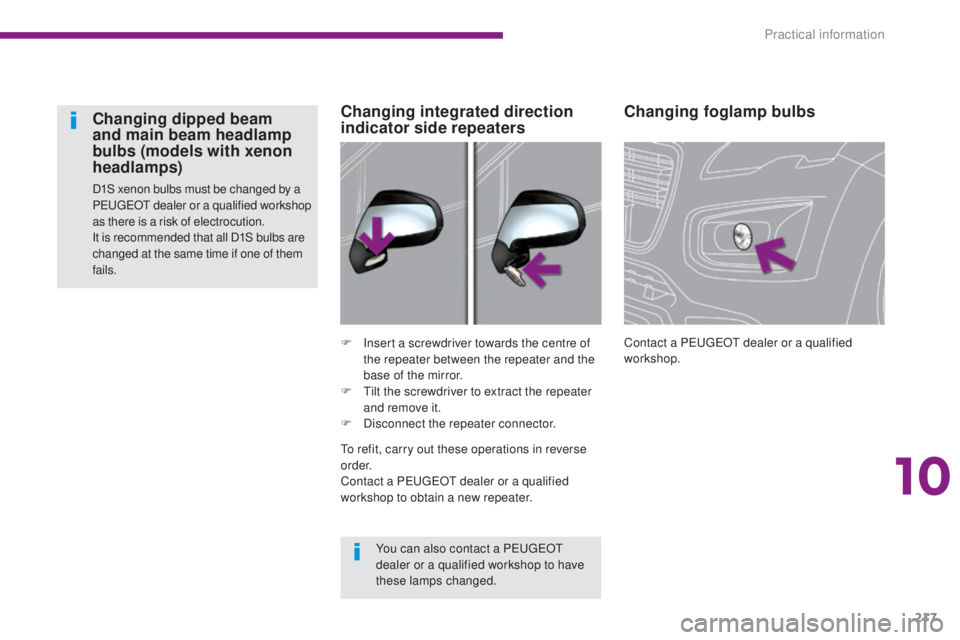
217
3008_en_Chap10_infos-pratiques_ed01-2015
Changing foglamp bulbs
Contact a PEUGEOT dealer or a qualified
workshop.
F
I
nsert a screwdriver towards the centre of
the repeater between the repeater and the
base of the mirror.
F
T
ilt the screwdriver to extract the repeater
and remove it.
F
D
isconnect the repeater connector.
Changing integrated direction
indicator side repeaters
Changing dipped beam
and main beam headlamp
bulbs (models with xenon
headlamps)
D1S xenon bulbs must be changed by a
PEUGEOT dealer or a qualified workshop
as there is a risk of electrocution.
It is recommended that all D1S bulbs are
changed at the same time if one of them
fails.
You can also contact a PEUGEOT
dealer or a qualified workshop to have
these lamps changed.
To refit, carry out these operations in reverse
o r d e r.
Contact a PEUGEOT dealer or a qualified
workshop to obtain a new repeater.
10
Practical information
Page 220 of 344
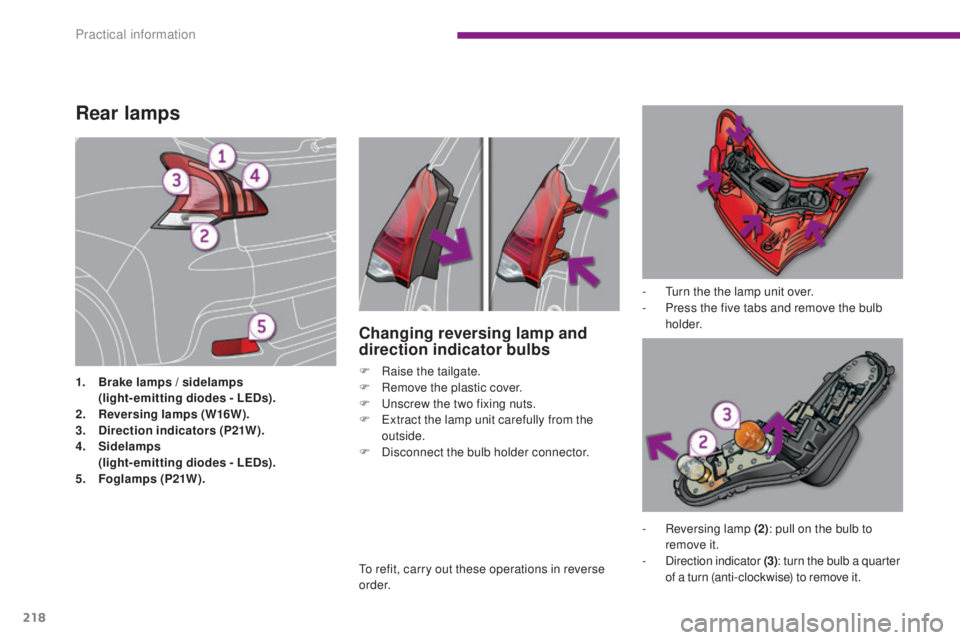
218
3008_en_Chap10_infos-pratiques_ed01-2015
Rear lamps
1. Brake lamps / sidelamps (
light-emitting diodes - LEDs).
2.
R
eversing lamps (W16W).
3.
D
irection indicators (P21W).
4.
S
idelamps
(
light-emitting diodes - LEDs).
5.
F
oglamps (P21W). -
T
urn the the lamp unit over.
-
P
ress the five tabs and remove the bulb
h o l d e r.
Changing reversing lamp and
direction indicator bulbs
F Raise the tailgate.
F R emove the plastic cover.
F
U
nscrew the two fixing nuts.
F
E
xtract the lamp unit carefully from the
outside.
F
D
isconnect the bulb holder connector. -
R
eversing lamp (2): pull on the bulb to
remove it.
-
D
irection indicator (3): turn the bulb a quarter
of a turn (anti-clockwise) to remove it.
To refit, carry out these operations in reverse
o r d e r.
Practical information